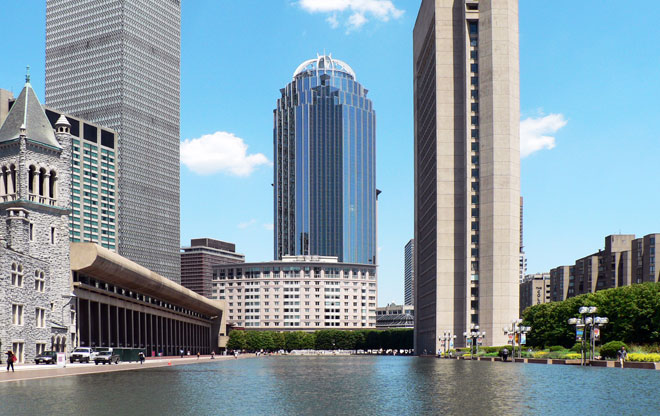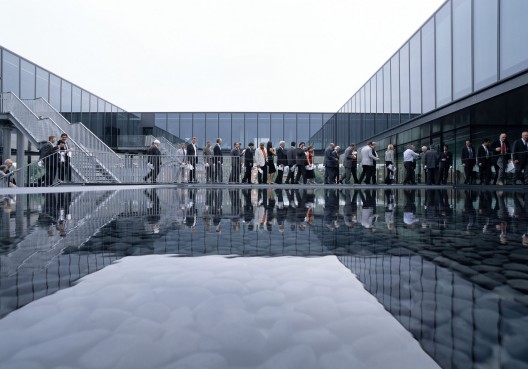 |
| Source: asla.org |
Christian Science Center, Boston, Massachusetts, USA 1970 designed by Pei Cobb Freed & Partners
A 670-foot-long reflecting pool along the eastern axis of the site helps to visually bind the different components together while providing a friendly realm for interaction with the surrounding city. The pool, located on the roof of a 600-car underground garage, also functions as the cooling tower for the complex. -- architect's web site
 |
| Source: galinsky.com |
Water Temple (Shingonshu Honpukuji), Hyogo, Japan, 1991 designed by Tadao Ando
The Temple, originally for the Shingon Buddhist Sect, is approached from a long uphill path traversing the original temple compound and cemetery. One is then directed, indirectly, through a simple series of two gesturing white-washed concrete walls of light and shadow that eventually lead one to what seems like a pool of water. The pool itself is filled to its outermost perimeter, forming a boundless horizon line about which it infinitely reflects its surroundings of mountains, sky, rice paddies and bamboo groves. The stillness of the water has a meditative effect and perhaps implications of a spiritual cleansing. -- galinksy
 |
| Source: Maurizio Marcato archdaily.com |
Ferrari Operational Headquarters and Research Centre, Maranello, Modena, Italy, 2004 designed by Studio Fuksas
The complex is in two parts. One volume is separated from the rest of the building and hovers above the entrance area where it extends 7 meters above water below. The water covers the second, lower volume. Walkways lie at the water line, connecting meeting rooms distinguished by vibrant colors. The building itself and its reflection along the water’s surface is a condition that challenges the concept of time and space within the architecture. -- ArchDaily
 |
| Source: Maurizio Marcato archdaily.com |
Nardini Grappa Distillery “Bolle”, Bassano Del Grappa, Vicenza, Italy, 2004 designed by Massimiliano and Doriana Fuksas
Visitors stroll over paths that criss cross over the pool. A descending ramp leads into the 100-seat auditorium below, forming a natural canyon. Underwater lights illuminate the surface, creating a shimmer across the grounds of the distillery and reflected in the floating volumes above. The procession between above and below is amplified by the passage through the surface of the water. It appears to be just a few centimeters deep from ground level, but once visitors descend into the submerged volume below it becomes clear that it extends for several meters. -- ArchDaily
 |
| Source: fr.wikipedia.org |
le miroir d'eau(the water mirror), Place de la Bourse, Bordeaux, France, 2006 designed by Michel Corajoud and J. M. Llorca
The beauty of Place de la Bourse becomes dreamlike when it is reflected in "le miroir d'eau", the reflecting pool. This 130 meter long and 42 meter wide set of granite slabs is the largest reflecting pool in the world. Conceived by the landscape architect Michel Corajoud, and developed by the fountain expert J. M. Llorca, it was, with "le jardin des lumières" (the garden of lights) and the skate park, one of the main elements of Bordeaux‘s quayside recent redevelopment.
"Le miroir d'eau" works according to a specific cycle. When the slabs are are almost dry, it looks like a huge slate. A few minutes later, the fountain mecanism produces plumes of mist, creating a thick fog turning the quay in a fairyland. When the fog disappears, the 3 450 square metres of granite are covered with 2 centimeters of a cristal clear water, becoming a slightly undulating twin of "Place de la Bourse". According to J. M. Llorca, the water mirror was inspired by the regular flooding of Saint Mark's Square Venice. -- French Moments
 |
| Source: Paul Hester archdaily.com |
Asia Society Texas Center, Houston, Texas, USA, 2011 designed by Yoshio Taniguchi
.... the Center’s orientation shifted to face Southmore Blvd., framing a great view of the downtown skyline from the enormous second story lounge window (so long as no other taller structures are built between the Center and the downtown skyline in the future, which is never a guarantee in Houston). This view also captures the water garden with infinity edge and steam machines that rise over the water, obscuring the ground line and creating an almost surreal disconnection from the street. -- ArchDaily
 |
| Source: Pieter Kers archdaily.com |
Ornamental Pond, Heemstede, The Netherlands designed by Hosper
The ornamental pond, with a water surface of 730 m² and a depth of 60 cm, has a rim of COR-TEN steel. Light shafts in the ornamental pond allow daylight into the underground car park. The openings are covered with coloured glass panels, each of which is an individual work of art. At night-time the light from the underground car park shining upwards through the panels results in a very special effect. In addition, the liveliness of the water is increased by the special fountains that are switched on at intervals and produce small bubbles just above the surface of the water. -- ArchDaily
 |
| Source: construction.com |
Serpentine Gallery Pavilion, London, UK, 2012 designed by Herzog & de Meuron and Ai Weiwei
To build a kind of manufactured archaeological site based on the previous 11 pavilions, the team created a drawing that fused the foundations of those structures into a single digital rendering, and then carved this form out of the ground. A massive dishlike steel roof supported by 12 steel columns wrapped in cork is a nod to the temporary canopies that cover fragile archaeological sites. It holds a shallow pool that reflects the neo-Georgian gallery across the lawn. -- Architectural Record
 |
| Source: Serie Architects archdaily.com |
BMW Group Pavilion, London, UK, 2012 designed by Serie Architects
The first floor that forms the plinth is covered with water; this water spills down on all four sides of the pavilion entirely covering the ground floor. The surface of the first floor is essentially a thin reflective pool. This pool reflects its environment: the cars, the visitors and the Olympic site. The GRP-lined reflecting pool is supplied through a series of sumps fitted with cover gratings. The water for the waterfall is drawn from the river by submersible pumps set on platforms above the river bed. -- ArchDaily
 |
| Source: Iwan Baan archdaily.com |
Daeyang Gallery and House, Seoul, Korea, 2012 designed by Steven Holl Architects
Three pavilions; one for entry, one residence, and one event space, appear to push upward from a continuous gallery level below. A sheet of water establishes the plane of reference from above and below. The idea of space as silent until activated by light is realized in the cutting of 55 skylight strips in the roofs of the three pavilions. -- ArchDaily
 |
| Source: Artech Architects archdaily.com |
Water-Moon Monastery, Taipei, Taiwan, 2012 designed by Artech Architects
After passing through two walls of different heights that serve as buffer from the expressway outside, upon entering the temple, visitors face the view of the Main Hall that sits at the far end of a 80-meter long lotus pond. The reflections on the pond of the over-sized colonnades and the flowing golden drapes in between create a scene of illusory quality. -- ArchDaily
No comments:
Post a Comment